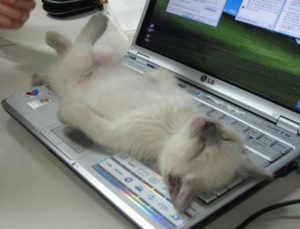By Dr. Beth Leermakers
Midnight zoomies. Kneading your shirt. Curling up in a shoe box. Have you ever wondered why your cat engages in some of these strange behaviors? These seemingly unusual behaviors may serve an adaptive purpose stemming from cats’ evolutionary origins. Kat Miller, Ph.D., director of anti-cruelty and behavior research at the ASPCA and a Certified Applied Animal Behaviorist, explains a few feline eccentricities:
Sleeping curled up in a tight ball. If your cat shares your bed, you may appreciate it when she curls up into a tiny ball instead of sprawling diagonally across the middle of the bed. Many mammals sleep this way to protect themselves and retain heat. Cats may squeeze into small spaces so they have solid walls against part of their body for security. As mob bosses know, it’s harder for a predator to sneak up on them if they’re up against a wall. Or cats may curl up into a ball for protection. Curling up is also a great way to retain heat. Think about how a bird sleeps with its wings or feet tucked in to stay warm.
Kneading. This behavior goes back to your cat’s younger days. Kittens knead their mother’s belly to stimulate milk production. Older cats often knead when they’re relaxed and comfortable. Whatever they’re kneading — your soft sweatshirt or a blanket — may remind Fluffy of her mom’s belly. Cats may also knead when they’re stressed or scared, as a way to soothe themselves.
Pawing at their litter box. Modern cats have descended from cats that lived in the desert (think: giant sand box). Some cats dig a hole to bury their waste before they go, while others cover it afterward. Covering their urine and feces is usually a way to mark their territory. Smell is one important way that cats define their space. If your cat’s litter box is located in an area where he doesn’t spend most of his time (i.e., outside his normal “territory”), he may not cover his feces, announcing via scent that he still considers the area his. If the litter box is inside his territory, he may cover up the smell, since cats are usually fastidious creatures.
Exposing their belly. When dogs roll onto their backs, they’re often inviting people to rub their belly. With cats it’s not so straight-forward. When your cat rolls onto her back, she may be in a happy, frisky mood, willing to let you rub her tummy. Although many cats don’t enjoy having their belly rubbed, they can learn to enjoy it if you start when they’re young. Another possibility is that your cat is protecting her belly, a vulnerable body part.
If she rolls onto her back when she’s upset or feeling feisty, she may be getting into position to use her back claws — her most powerful weapon. If your cat is in the mood for play fighting, you may see her claws come out when you innocently reach toward her stomach. Ouch! Cats should come with behavior decoder manuals.
Sleeping in boxes or bags. Cats are natural ambushers that like to hide so they can observe their target from a distance. Your shopping bag provides excellent cover, as well as a sense of security and way to retain heat.
Midnight play time. Just as you’re falling asleep, your cat springs to life, doing kitty zoomies on your bed and pawing at your face, eager to play. What’s up with that? Cats naturally have a different sleep/wake cycle than people do. Cats sleep many times throughout the day and night, not just at night.
Therefore, they may naturally be awake at 2 am. Furthermore, your cat may realize that daytime, when people are gone, is rest time, and evening — when their pack is together — is play time. When you wake up and pay attention to your cat, you’re rewarding her playful behavior, increasing the likelihood that her midnight antics will be repeated.
Sitting on your computer. When it’s turned on, your warm computer feels like a feline electric blanket Since it’s nearly impossible to ignore a cat that’s staring at you while you’re trying to type, you’re more likely to pay attention to your cat when she’s camped out on your keyboard.
Rubbing their face on things. Cats use scent to define their territory. With scent glands on their face (as well as other body parts), they mark people and objects as “mine” for the benefit of other cats. Your cat is decorating her house with her scent. Cats are more likely to rub their faces when they’re feeling comfortable and part of the family.
The next time your cat engages in one of these behaviors, think about what he’s trying to tell you. Does he want more attention, play time or mental stimulation? As far as your cat is concerned, it’s your job to cater to his needs. What are you waiting for?

